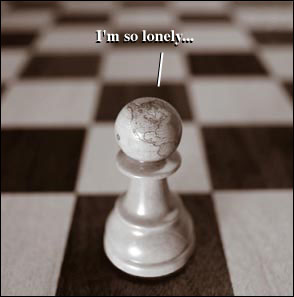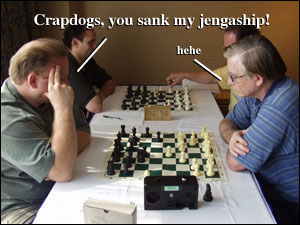

Board Game Military Science:
spice up your chess game with
these exciting new recipies!
by Dan Kotler
The American Military Engagement Chess Emulation
On the "American" side, every piece gets to move like a Queen. This illustrates
the overwhelming technological edge.
On the enemy side, all the pieces act like pawns, except that the bishops and
knights both get to move like knights in consideration of the enemy's guerilla
tactics, and the king still gets to run away, err, move normally.
The enemy plays white, because guerillas get to go first. The American side has
to win without losing more than one piece--if America loses a second piece, the
home front loses patience and demands the troops come home.
Have fun!
The WWII French-German Chess Emulation:
The German side plays white (because blitzkrieg always goes first), and all the
pieces move like queens. (The King, or Fuhrer, still retains its check-mateable
properties, i.e. the French have to check-mate the King to win.)
The French side is laid out as normal, except that the last 3 pawns on the King's
side of the board are missing. Also, none of the pawns can move. Ever.
The WWI Chess Emulation:
The non-pawn pieces (the "officers") line up in their normal places. They don't
move.
All the intervening ranks are filled with pawns, white on the white side up to the
center, black on the black side up to the center. Officers never move up. If
necessary, though, they can draft [1/2 D6 - 1] new pawns per round. No side can
have more pawns than can fit on the board; if you roll a fraction, you have to
wait until the fractions add up to a whole number.
The game ends when, by some miracle, any officer gets killed (the side that
killed the officer wins). The game can also end when any player gets fed up with
the whole thing, stages a people's revolition, deserts en masse, and sues for a
separate piece. In that case nobody wins.

See Also:
Board Game Social Studies, by Dan Kotler
Board Game Theology, by Dan Kotler
go home, smelly american pig-dogs
|